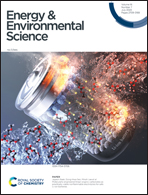High reversibility at high current density: the zinc electrodeposition principle behind the “trick”
Abstract
Electric systems typically exhibit an efficiency decline as current density increases due to mass-transport limitations, but high reversibility of zinc plating/stripping and its in-planar morphology and texture have been observed at high current density. In this opinion article, a contradicting phenomenon is discussed with a specific focus on its underlying mechanisms, current status, and prospective research directions. In addition to traditional studies that have solely focused on Zn electrodeposition behaviors, we underscore the previously neglected yet significant role of the hydrogen evolution reaction (HER) and its interaction with Zn electrodeposition behaviors. High current density operation has been found to suppress the HER and preserve a neat surface for Zn electrodeposition, providing a valuable insight into explaining the intriguing high Zn reversibility observed at high current density. Furthermore, we believe that ultra-high Zn reversibility achieved at low capacity may lead to misconceptions in data interpretation and is far from meeting the criteria of high-capacity Zn batteries. Therefore, we recommended a comprehensive analysis that incorporates the HER and a high-capacity battery test protocol for reliable data analysis.



 Please wait while we load your content...
Please wait while we load your content...